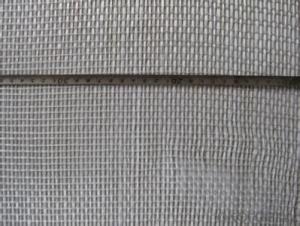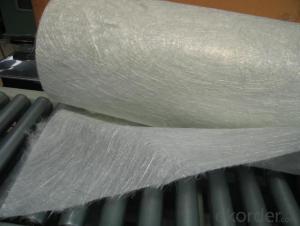E-GLASS STITCH COMBO MAT- QX
- Loading Port:
- China Main Port
- Payment Terms:
- TT or LC
- Min Order Qty:
- -
- Supply Capability:
- -
OKorder Service Pledge
OKorder Financial Service
You Might Also Like
Brief Introduction: E-glass stitched combo mat consists of two or more layers of fiberglass roving which are stitch-bonded.One layer of rovings and different layers of roving can be oriented differently and have different liner density.The roving specification,number of roving layers,mat width and roll diameter can be customized as per requirement. |
Multi-axial series: At most 4 layers of roving can be stitched;however a layer of chopped strands(0g/㎡-500g/㎡)or composite materials can be added.The maximal width can be too inched.This product is used in blades of wind power turbines,boat manufacturing and sports devices. |
Characteristics
1. Manufactured by own factory
2. Good wet-out in resins
3. Good strand dispersion and uniform area weight.
Specification
4 QX 0°/+45°/90°/-45° Quadraxial |
Product No. | Overall Density | 0°Roving Density(g/㎡) | +45°Roving Density (g/㎡) | 90°Roving Density(g/㎡) | -45°Roving Density(g/㎡) | Chop Density | Polyester Yarn Density(g/㎡) |
E-QX320 | 320.97 | 1.91 | 155.9 | 1.91 | 155.9 | - | 5.35 |
E-QX450 | 460.15 | 1.91 | 225.49 | 1.91 | 225.49 | - | 5.35 |
E-QX600 | 610.49 | 1.91 | 300.66 | 1.91 | 300.66 | - | 5.35 |
E-QX800 | 810.93 | 1.91 | 400.88 | 1.91 | 400.88 | - | 5.35 |
E-QX1000 | 1018.96 | 1.91 | 491.37 | 27.56 | 491.37 | - | 6.75 |
E-QX1150 | 1145.61 | 287.4 | 284 | 283.46 | 284 | - | 6.75 |
E-QX1200 | 1217.7 | 602.36 | 300.66 | 4.02 | 300.66 | - | 10 |
E-QXM620/98 | 722.33 | 15.75 | 300.66 | 1.91 | 300.66 | 98 | 5.35 |
E-QXM1300/128 | 1422.52 | 574.8 | 212.13 | 283.46 | 212.13 | 128 | 12 |
E-QXM1850/225 | 2104.06 | 472.44 | 467.69 | 462.99 | 467.69 | 225 | 8.25 |
FAQ
a.Pacage
Each Eglass stitched Combo Mat is wound onto a paper tube The roll is wrapped up with plastic film,and then packed in a cardboard box. The rolls can be vertically or horizontally placed. For transportation, the rolls can be loaded into a container directly or on pallets.
b.Product storage:
Unless otherwise specified, CHEMICAL FIBER GRIDDING CLOTH should be stored in a dry, cool and rain-proof area. It is recommended that the room temperature and humidity should be always maintained at 15℃~35℃ and 50%~75% respectively.
- Q:Are fiberglass fabrics resistant to moisture or humidity?
- Yes, fiberglass fabrics are highly resistant to moisture and humidity. This is because fiberglass itself is made from fine fibers of glass, which do not absorb water or allow moisture to pass through easily. The structure of fiberglass is non-porous and does not support the growth of mold or mildew, making it an ideal material for applications where exposure to moisture or humidity is common. Additionally, fiberglass fabrics can withstand high levels of moisture without losing their strength or integrity, making them a reliable choice for various industries including construction, marine, and automotive.
- Q:Mural and wallpaper are different, which should pay attention to choosing murals?
- Murals and wallpaper are two concepts, the murals are a custom-made pattern, according to the actual size of the wall made, and wallpaper is a regular pattern, so murals are usually used for local posting.
- Q:Can fiberglass fabric be used for geotextiles?
- Certainly! Geotextiles can indeed utilize fiberglass fabric. This material is incredibly versatile and possesses exceptional strength, durability, and resistance against harsh environmental conditions. It finds widespread use in numerous applications, including geotextiles. Geotextiles, in turn, refer to synthetic materials employed in civil engineering and construction projects to reinforce soil, segregate different soil layers, and combat erosion. The fiberglass fabric employed for geotextiles is specially engineered to possess high tensile strength, enabling it to withstand soil-induced forces. It effectively reinforces feeble soils, stabilizes slopes, and prevents soil erosion. Moreover, fiberglass fabric geotextiles exhibit resistance to chemicals, UV radiation, and biological degradation, ensuring prolonged performance under challenging environmental circumstances. There are several advantages to employing fiberglass fabric geotextiles. Firstly, they exhibit excellent filtration properties, permitting water passage while retaining soil particles. This aids in maintaining soil structure stability and drainage. Secondly, fiberglass fabric geotextiles are lightweight and easy to install, reducing labor and time expenses. Lastly, they boast a lengthy service life and require minimal maintenance, thereby proving a cost-effective solution for geotechnical applications. On the whole, fiberglass fabric can be reliably and durably employed for geotextiles, providing robust reinforcement for diverse civil engineering and construction projects.
- Q:Can fiberglass fabric be used for curtains and drapes?
- Yes, fiberglass fabric can be used for curtains and drapes. It is a versatile material that offers durability, resistance to fire, and is lightweight. Additionally, fiberglass fabric can provide privacy while allowing natural light to filter through.
- Q:What are the different fiberglass fabric weaves for high strength applications?
- There are multiple fiberglass fabric weaves commonly utilized for high strength applications, including plain weave, twill weave, satin weave, and leno weave. 1. Plain weave: This weave pattern is the most fundamental and widely used. It involves an over-under pattern, with each warp yarn passing over and under each weft yarn. Plain weave fabrics offer exceptional strength and dimensional stability, making them appropriate for a wide range of high strength applications. 2. Twill weave: Twill weave is characterized by a diagonal pattern formed by the interlacing of warp and weft yarns. This weave is renowned for its strength and durability. Twill weave fabrics possess good drapability, making them ideal for applications requiring flexibility and resistance to wrinkling. 3. Satin weave: Satin weave is identified by long floats, where the warp or weft yarns skip over multiple yarns in the opposite direction. This creates a smooth and glossy surface. Satin weave fabrics boast excellent strength and are commonly used in applications desiring a high-quality finish, such as aerospace components and luxury goods. 4. Leno weave: Leno weave is a distinctive pattern that involves twisting adjacent warp yarns around each weft yarn. This creates a stable and open structure with good strength and stability. Leno weave fabrics find common use in high strength applications where breathability and lightness are crucial, such as filtration systems and composites. These various fiberglass fabric weaves offer different levels of strength, flexibility, and durability, enabling manufacturers to select the most suitable weave for their specific high strength applications.
- Q:Is fiberglass fabric suitable for use in automotive interiors?
- Automotive interiors benefit greatly from the use of fiberglass fabric. This material is renowned for its durability, strength, and ability to withstand high temperatures and fires. These exceptional properties make it an excellent option for automotive interiors, where it can endure daily wear and tear and provide exceptional protection. In the automotive industry, fiberglass fabric is extensively utilized for various purposes. It serves as a reinforcement material for seats, headliners, door panels, and other interior components. Its remarkable tensile strength ensures that the fabric can withstand the pressure and stress placed on these parts, ensuring their longevity. Moreover, fiberglass fabric is commonly employed as a sound and heat insulator in automotive interiors. Its thermal characteristics help to reduce heat transfer, keeping the cabin cooler during hot weather. Additionally, it effectively dampens sound vibrations, resulting in a quieter and more comfortable driving experience. Furthermore, fiberglass fabric's resistance to moisture, mold, and mildew makes it an ideal choice for automotive interiors exposed to diverse weather conditions. It is also effortless to clean and maintain, which is vital for preserving the aesthetics and functionality of the interior components. In conclusion, fiberglass fabric offers a multitude of advantages that render it suitable for automotive interiors. Its strength, durability, heat resistance, and insulation properties make it a favored option among manufacturers and designers seeking to create top-notch, long-lasting, and comfortable automotive interiors.
- Q:What color steel plate is good for dust-free workshop?
- The mechanism of mechanical production, forming a middle filled with rock wool, polyurethane, foam and other materials. Both male and female connection. Widely used in industrial production of non load bearing wall, roof, ceiling and single layer composite housing bearing wallboard, mainly used in electronics, semiconductor, medicine, biology, food and other clean room purification partition ceiling.
- Q:Roof with a single group of waterproof coating and glass fiber cloth done, but the past is still in the seam water seepage, how should remediation?
- Without plugging king, deep 2CM can clean up the gap, using block gap ointment caulking first brush a waterproof coating and sealing, and waterproof paint.
- Q:How does fiberglass fabric perform in terms of fire resistance?
- The fire resistance properties of fiberglass fabric are well-known. It possesses a high melting point and does not easily ignite due to its composition of woven glass fibers. When exposed to flames, it does not burn or release harmful gases, making it suitable for applications where fire safety is of utmost importance. Furthermore, fiberglass fabric has the ability to self-extinguish, meaning that it stops burning once the heat source is removed. This characteristic aids in preventing the spread of fire and contributes to overall safety. In addition, fiberglass fabric has low thermal conductivity, meaning it does not conduct heat effectively. This property helps contain the fire and reduces the risk of its spreading. The fabric also acts as a barrier between the heat source and the surrounding area, minimizing heat transfer and providing protection to nearby materials. In conclusion, fiberglass fabric is highly esteemed for its exceptional fire resistance properties, making it a preferred choice in industries such as aerospace, automotive, construction, and firefighting.
- Q:Is fiberglass fabric resistant to insects?
- Yes, fiberglass fabric is generally resistant to insects.
1. Manufacturer Overview |
|
|---|---|
| Location | |
| Year Established | |
| Annual Output Value | |
| Main Markets | |
| Company Certifications | |
2. Manufacturer Certificates |
|
|---|---|
| a) Certification Name | |
| Range | |
| Reference | |
| Validity Period | |
3. Manufacturer Capability |
|
|---|---|
| a)Trade Capacity | |
| Nearest Port | |
| Export Percentage | |
| No.of Employees in Trade Department | |
| Language Spoken: | |
| b)Factory Information | |
| Factory Size: | |
| No. of Production Lines | |
| Contract Manufacturing | |
| Product Price Range | |
Send your message to us
E-GLASS STITCH COMBO MAT- QX
- Loading Port:
- China Main Port
- Payment Terms:
- TT or LC
- Min Order Qty:
- -
- Supply Capability:
- -
OKorder Service Pledge
OKorder Financial Service
Similar products
New products
Hot products
Hot Searches
Related keywords



























